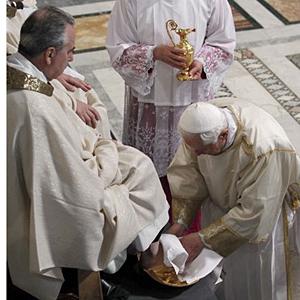
Lent ends and the sacred Triduum begins with the Mass of Our Lord’s Supper, with the rite of Washing of Feet (known also as the Mandatum). In Rome, the Pope offered Mass at the Casal del Marmo, an inner city detention center. In the chapel dedicated to the title of “Father of Mercies,” were 40 young detainees gathered around him for Mass, 12 youth, Catholics and non-Christians, 2 of whom were young women and 2 Muslims, had their feet washed by the Pontiff. Concelebrating the Mass were Cardinal Agostino Vallini (the Pope’s Vicar for the Diocese of Rome), Archbishop Giovanni Angelo Becciu (‘Substitute for General Affairs of the Secretary of State), Monsignor Alfred Xuereb, (Chaplain to the Casal del Marmo, and papal secretary), 2 deacons, one deacon from the Seminario San Carlo (the Seminary of the Fraternity of St Charles Borromeo) and another, Brother Roi Jenkins Albuen, a Capuchin of the “Addolorata” with Father Gaetano Greco. Also there were two young seminarians from the Roman Seminary with the assistant chaplain, Colombian Father Pedro Acosta.
Pay attention to what the Pope says!!!! Also, some photos.

Here’s Vatican Radio transcript and translation of the Holy Father’s unscripted homily:
“This is moving, Jesus washes the feet of his disciples. Peter understands nothing. He refuses but Jesus explains to him. Jesus, God did this, and He Himself explains it to the disciples.. ‘Do you realize what I have done for you? You call me ‘teacher’ and ‘master,’ and rightly so, for indeed I am. If I, therefore, the master and teacher, have washed your feet, you ought to wash one another’s feet. I have given you a model to follow, so that as I have done for you, you should also do’.
Continue reading Francis’ homily for Holy Thursday 2013



